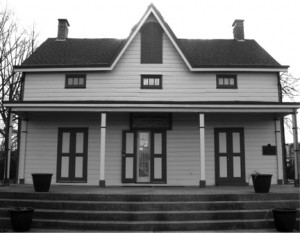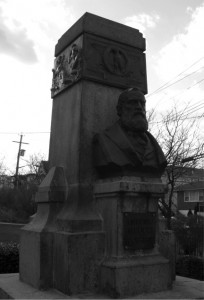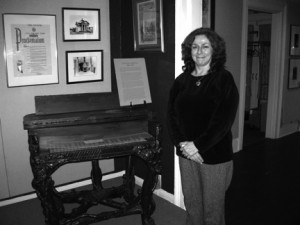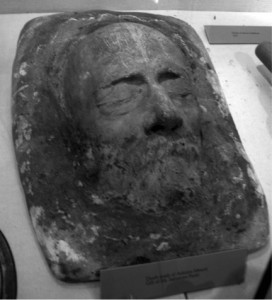Is the Garibaldi-Meucci Museum haunted by the spirit of the rightful inventor of the telephone?
From Ghosthunting New York by L’Aura Hladik

Located on Staten Island, the Garibaldi-Meucci Museum houses historical displays and artwork and hosts Italian cultural classes. The museum also provides ghosthunters with paranormal activity to explore, but to fully understand it, we must get to know the two famous Italians for whom the museum is named. Guiseppi Garibaldi is known as the George Washington of Italy. He fought for the unification of the twenty Italian city-states. Sadly for him, his hometown of Niza ended up becoming Nice, France, when the final borders of Italy were determined. In addition to fighting in Italy and being exiled, Garibaldi fought in
South America in support of Brazil’s war against Spain. It was in Brazil that he met the love of his life, Anita. They married and had four children together. Later, Garibaldi fought for Uruguay when it was invaded by Argentina. In Uruguay he was given a red shirt to wear, and this became the uniform for his fellow soldiers. They were known as “the Red Shirts.” Eventually Garibaldi returned to Italy with his wife and children so that he could fight once more to unite Italy. The Catholic states’ army overwhelmed Garibaldi’s men, and he was condemned to death. His wife had died during the battle; therefore, he left his children with his mother and fled to America to escape execution.
Antonio Meucci was born in Florence, Italy, and attended Accademia di Bell’ Arte (the Academy of Fine Arts), where he studied chemical and mechanical engineering. He met his future wife, Ester Mochi, when she was a costume seamstress at a local opera company where he was working as a stage technician. They married in 1834, and in 1835, they moved with the opera company to Havana, Cuba. They stayed in Cuba for fifteen years before relocating to America in 1850. The home they rented, built ten years prior in 1840, eventually became the Garibaldi-Meucci Museum. Meucci was a prolific inventor. In fact, he had a prototype for an electromechanical telephone when Alexander Graham Bell was only two years old. Although Meucci couldn’t explain electricity— he was an inventor, not a scientist—he did discover that sound, encoded as electrical impulses, would travel over copper wires. In 1854, Meucci used his “teletrefono,” as he called it, in his Staten Island home. The device allowed his wife, who was ill and bedridden, to call from her bedroom to his workshop if she needed something. In 1860, Meucci didn’t have the $250 necessary to secure a patent for his device. However, his lab partner at the time, Alexander Graham Bell, did have the money. Bell also had a powerful businessman named Hubbard as his future father-in-law. The well-connected Hubbard called in a favor or two that allowed his future son-in-law to submit for a patent for a tweaked version of Meucci’s invention. Bell’s design didn’t work, yet he was allowed to correct and resubmit his application, and within three weeks the patent was granted. Even today, such a quick turnaround for a patent is unheard of.

Curiously, Meucci’s paperwork and designs disappeared from the patent office around the time Bell was submitting for the patent. Meucci spoke only broken English, which cost him dearly in the effort to protect his business interests. He was truly taken advantage of by Bell and other big names of the day. For years, Meucci contested ownership of the telephone patent. Sadly, he died in 1899, before his case against Bell could be heard by the Supreme Court. But in 2002, the U.S. House of Representatives finally acknowledged Meucci as the inventor of the telephone.
So how were Garibaldi and Meucci connected? Garibaldi arrived in New York shortly after the Meuccis had moved into their home on Staten Island in 1850. Meucci insisted that Garibaldi stay with him and his wife, and Garibaldi ended up living with the Meuccis for six months—although the plaque above the entrance says he lived there for four years, probably because he returned to Italy in 1854 to continue the fight for unification. The house was moved to its present location in 1907, and a pantheon structure was built over it to convert it to a temple paying homage to Garibaldi. The pantheon was removed in the early 1950s because it was deteriorating. When you enter the house today, you’re actually coming in the back door; the house was rotated when placed on the property so that the sign announcing Garibaldi as “Hero of Two Worlds” would face the street. Meucci and his wife both died in residence at this house and are buried on the property. It’s possible that the rightfully disgruntled energies of Meucci may account for the otherwise inexplicable banging noises sometimes heard there.
The staff at the Garibaldi-Meucci Museum experiences cold spots and banging noises

I spoke with Bonnie McCourt, publicity coordinator at the museum, and she said that she has yet to experience anything paranormal there. Her boss, Nichole, the museum director, is relatively new to her post and has not encountered anything unusual there either. Nichole did say, however, that her predecessor had experienced cold spots and banging noises and was once pushed by an unseen hand as she ascended the stairs on her way to her second-floor office. Nichole suggested I speak with Amy Raiola, Founder and Lead Investigator for the Staten Island Paranormal Society. I did just that. Amy first investigated the Garibaldi-Meucci Museum in 2006. She told me that initially her team tracked a cold spot that moved throughout the museum. In fact, just after they entered the museum, it felt so cold that they decided to check the furnace. One woman on the team opted to run back to her car to retrieve her coat while the remaining team members inspected the furnace. By the time she got back into the museum with her coat, the place was hot—not just warmed up, but hot. Amy confirmed the furnace and heat were working properly. They realized that the cold spot moved around the museum, causing the furnace to run hotter than normal to compensate for the varying spots of extreme cold. Once the cold spot moved on, the space would revert back to being “extra toasty.” The team also obtained photos of orbs and various EVP recordings.
Investigation at the Garibaldi-Meucci Museum

In 2007, Amy and her team played host to Chris Moon of Haunted Times magazine and his Ghost Hunter’s University. The investigation at the Garibaldi-Meucci Museum incorporated the “Spirit Com” communication device Moon developed based on Thomas Edison’s original designs and ideas. Amy said it sounded as if voices from “the great beyond” were communicating via the “Spirit Com,” but that no words were discernable. “It was very faint or garbled sounding,” Amy said. As the night wore on, several members of the team left the site to get something to eat. Amy and the remaining seven investigators continued their work. After a while, they called it quits and began packing up their equipment. Just as they had gotten everything packed and ready to be hauled to their cars, they heard a loud bang from upstairs in the library.Amy described it as the sound of a large television falling off its stand.
The investigators rushed to the foot of the stairs. Amy was about to go upstairs to inspect, but she refrained, thinking it was probably one of the other investigators who was hiding up there and would jump out to scare her. Another team member volunteered to go upstairs. When his foot landed on the third stair, they heard a woman’s voice emanating from the top of the staircase, just outside the door to Garibaldi’s room. The woman’s voice was loud enough to be heard by everyone, but she was mumbling, so her words were not clear. Amy and a couple other investigators ran to their equipment cases and grabbed what they could. Chris Moon, with his audio recorder, was the first one upstairs. Amy followed with her camcorder. Amy said her video camera was working perfectly as she went up the stairs. As she approached the library, one of the investigators called out, “Matilda, is that you?” (Amy informed me that, over the course of their research, they had discovered the name “Matilda” in the museum’s paperwork.) Chris Moon’s audio recorder captured the ghostly woman’s response: “Yes.” Right after that EVP, Amy’s camcorder displayed lines across its screen and then shut down; it has not functioned since.
The day I went to the Garibald-Meucci Museum was not the best time to attempt to record for EVPs, though I tried. The offices on the second floor were full of activity such as phone calls and a radio playing in the background. I heard a loud crash, but it was not a paranormal one; it was merely a stack of files on the edge of a counter falling to the floor. Amy invited me to investigate the museum with her team the next time they go there. I simply cannot refuse. I want to know if Meucci’s restless spirit is wandering there. Is he unaware of his posthumous recognition as the inventor of the telephone? Could the ghost of his wife be the mumbling woman at the top of stairs? Either way, Meucci should be proud . . . talk about a long-distance call!